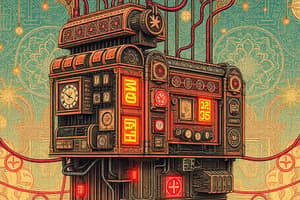Podcast
Questions and Answers
What is the primary function of a latch in digital electronics?
What is the primary function of a latch in digital electronics?
To store a bit of information
What are the two inputs of an SR latch?
What are the two inputs of an SR latch?
S (set) and R (reset)
What type of device is a latch classified as?
What type of device is a latch classified as?
Level-sensitive device
What is the purpose of a D flip-flop in digital circuits?
What is the purpose of a D flip-flop in digital circuits?
What is the term used to describe the data stored in a latch or flip-flop?
What is the term used to describe the data stored in a latch or flip-flop?
What type of digital circuits are flip-flops and latches used to build?
What type of digital circuits are flip-flops and latches used to build?
What are some examples of digital systems that use flip-flops and latches?
What are some examples of digital systems that use flip-flops and latches?
What digital logic functions can be implemented using flip-flops and latches?
What digital logic functions can be implemented using flip-flops and latches?
What is the main difference between a latch and a flip-flop?
What is the main difference between a latch and a flip-flop?
What is the significance of flip-flops and latches in digital electronics?
What is the significance of flip-flops and latches in digital electronics?
Flashcards are hidden until you start studying
Study Notes
Here are the study notes for the provided text:
Introduction to Flip-Flops and Latches
- The topic of today's lecture is about flip-flops and latches, and how they are used to store data
- The lecturer will explain the concept of storage and how it is used in digital electronics
Definition of Latch
- A latch is a type of digital circuit that can store a bit of information
- It is a bistable device that can be in one of two states: 0 or 1
- A latch is a level-sensitive device, meaning that it can be changed by the input signal
SR Latch
- An SR latch is a type of latch that has two inputs: S (set) and R (reset)
- The S input sets the latch to 1, while the R input resets the latch to 0
- The SR latch can be in one of four states: S=0, R=0; S=0, R=1; S=1, R=0; and S=1, R=1
- The SR latch is used to store a bit of information and can be used to build more complex digital circuits
D Flip-Flop
- A D flip-flop is a type of flip-flop that has a single input: D (data)
- The D flip-flop stores the value of the input signal and outputs it on the next clock cycle
- The D flip-flop is a edge-sensitive device, meaning that it can be changed by the rising or falling edge of the clock signal
- The D flip-flop is used to build sequential logic circuits
Stored Data
- The data stored in a latch or flip-flop is called the "stored data"
- The stored data can be changed by the input signal and is retained even when the input signal is removed
- The stored data is used to build sequential logic circuits and to implement digital systems
Application of Flip-Flops and Latches
- Flip-flops and latches are used to build sequential logic circuits, such as counters, registers, and shift registers
- They are used in digital systems, such as computers, smartphones, and other digital devices
- Flip-flops and latches are used to implement digital logic functions, such as AND, OR, and NOT gates
Summary
- Flip-flops and latches are used to store data and implement digital logic functions
- They are used in digital systems and are essential components of digital electronics
- The SR latch and D flip-flop are two types of flip-flops and latches that are commonly used in digital circuits
Introduction to Flip-Flops and Latches
- Flip-flops and latches are used to store data and implement digital logic functions
- Storage is a fundamental concept in digital electronics
Definition of Latch
- A latch is a bistable device that can store a bit of information (0 or 1)
- Latches are level-sensitive devices, meaning they can be changed by the input signal
SR Latch
- An SR latch has two inputs: S (set) and R (reset)
- S input sets the latch to 1, while R input resets the latch to 0
- SR latch can be in one of four states: S=0, R=0; S=0, R=1; S=1, R=0; and S=1, R=1
- SR latch is used to store a bit of information and build more complex digital circuits
D Flip-Flop
- A D flip-flop has a single input: D (data)
- D flip-flop stores the value of the input signal and outputs it on the next clock cycle
- D flip-flop is an edge-sensitive device, meaning it can be changed by the rising or falling edge of the clock signal
- D flip-flop is used to build sequential logic circuits
Stored Data
- Stored data is the information stored in a latch or flip-flop
- Stored data can be changed by the input signal and is retained even when the input signal is removed
- Stored data is used to build sequential logic circuits and implement digital systems
Application of Flip-Flops and Latches
- Flip-flops and latches are used to build sequential logic circuits, such as counters, registers, and shift registers
- They are used in digital systems, such as computers, smartphones, and other digital devices
- Flip-flops and latches implement digital logic functions, such as AND, OR, and NOT gates
Studying That Suits You
Use AI to generate personalized quizzes and flashcards to suit your learning preferences.




